Choosing the right eCommerce platform is vital for the commercial success of your online business. This article shortlists the 13 best eCommerce platforms on the market. We analyze their eCommerce features such as product listing, inventory management, payment integration and abandoned cart recovery features. We then define eCommerce platforms and their 2 types: hosted and self-hosted. Finally, we explain how to choose the best eCommerce platforms for your own needs. Let’s begin.
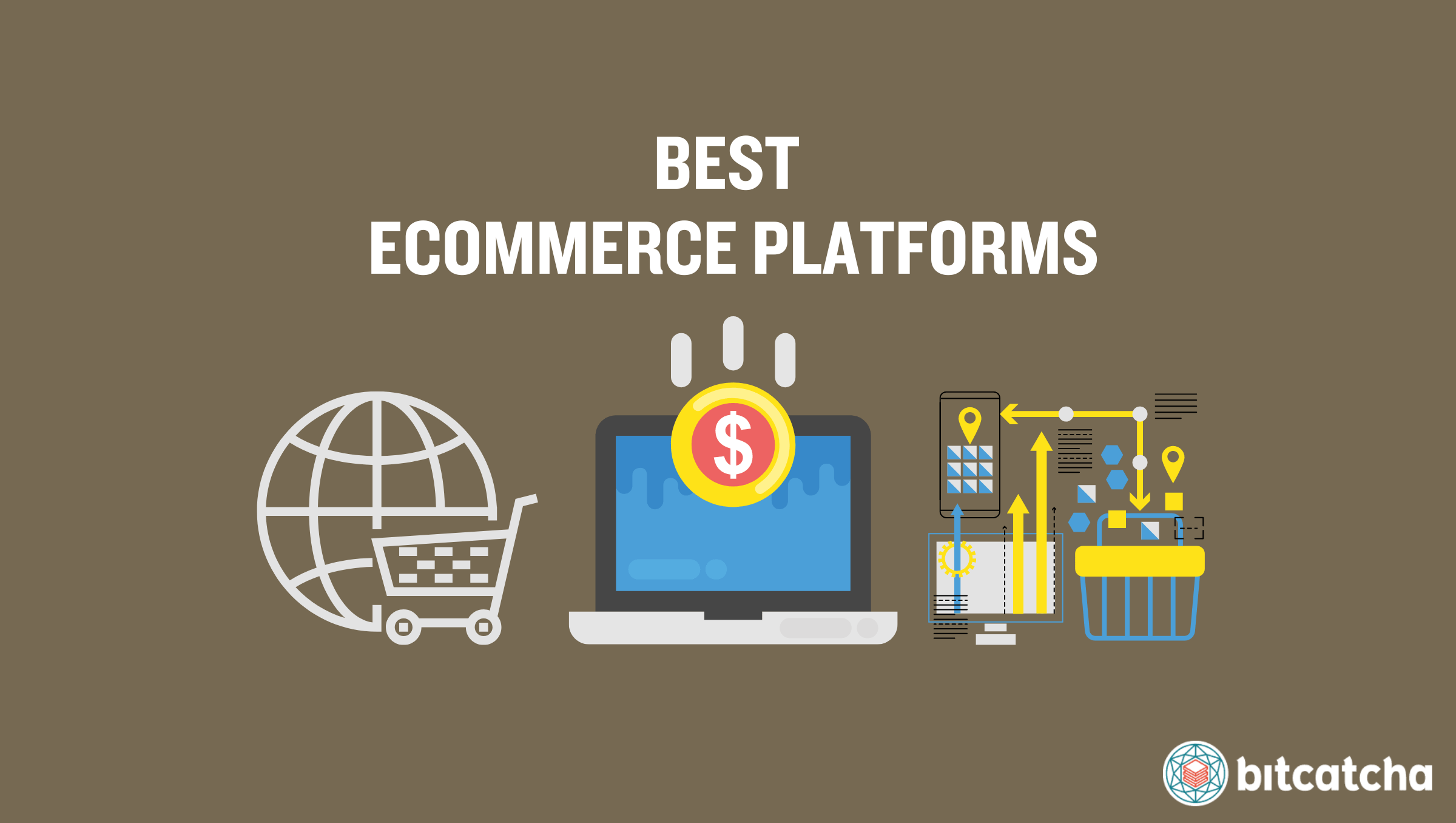

1. Hostinger
https://www.hostinger.com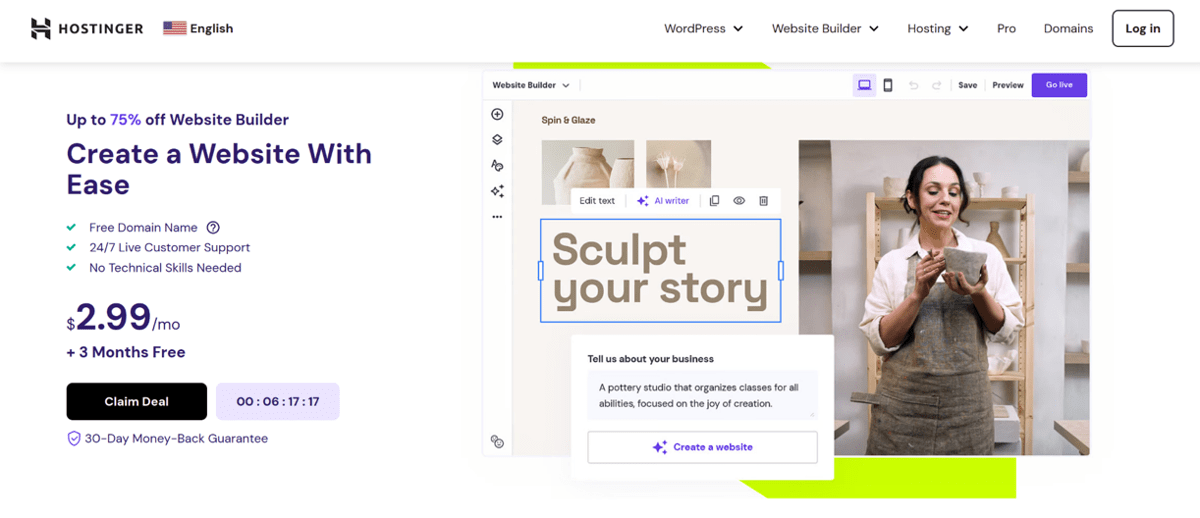
Hostinger Website Builder is the proprietary website builder created by the web host provider Hostinger. This platform provides a simple drag-and-drop interface that allows you to create an eCommerce website in mere minutes.
Hostinger Website Builder offers robust product listing features. You’re able to list up to 500 products with customizable product pages. Each product page accommodates multiple images, detailed descriptions, prices, and product variations. Hostinger Website Builder offers abandoned cart recovery features in the form of automatic reminder emails to customers who leave items in their carts.
It also provides an intuitive eCommerce management suite. Users track stock levels in real-time, receive notifications for low stock, and process orders efficiently. It supports over 20 payment options worldwide, including all major credit cards, PayPal, and local payment methods. SSL certificates (Secure Sockets Layers) and fraud detection tools ensure secure transactions. There are no transaction fees on sales.
Hostinger offers 24/7 customer support through live chat and email. It also provides a wealth of learning materials, including written tutorials and helpful videos available on its Hostinger Academy YouTube channel.
How Much Does Hostinger Website Builder Cost?
Hostinger Website Builder costs $2.99 per month for its Premium Website Builder and $3.99 per month for its Business Website Builder. Both plans include 150 templates, marketing integrations, and 24/7 customer support. The Business plan additionally offers advanced AI tools, eCommerce features, and AI-powered content creation tools. Note that Hostinger Website Builder is included for free in all Hostinger web hosting plans.
What Are the Pros and Cons of Hostinger Website Builder?
There are 4 pros of Hostinger Website Builder. The first is a wide range of 150 templates. The second is 24/7 customer support available. The third is seamless integration with Hostinger’s excellent web hosting services. The fourth is advanced AI tools and eCommerce features on their higher-tier Business plan.
There are 2 cons of Hostinger Website Builder. The first is it provides a very basic builder interface and this limits your ability to customize your design. The second is it offers limited integrations with other third-party apps, compared to competitors.

2. Shopify
https://www.shopify.com
Shopify is a well-known Canadian eCommerce website builder that enables you to create an online store quickly using its drag-and-drop builder and pre-made templates.
The platform supports unlimited products, which allows you to scale your inventory as needed. Users create detailed product pages with multiple images, descriptions, and pricing options. Shopify also lets you track stock levels, manage orders, and process returns with ease. Shopify’s abandoned cart recovery feature automatically sends reminder emails to customers who leave items in their carts.
Shopify is compatible with over 100 payment solutions worldwide. Users in eligible locations have the option to use Shopify Payments to avoid additional transaction fees. On the seller’s side, Shopify charges transaction fees ranging from 0.5% to 2% on each sale depending on your plan. Sellers also have the option to use Shopify Payments to bypass these fees.
Shopify provides 24/7 customer support through phone, live chat, and email. Shopify also offers extensive documentation and tutorials for platform navigation and optimization.
How Much Does Shopify Cost?
Shopify costs between $19 to $2,300 a month. Shopify offers four main pricing plans: Basic, Shopify, Advanced and Plus. The Basic plan ($19/mo) is ideal for solo entrepreneurs and includes 10 inventory locations. The Shopify plan ($49/mo) is suitable for small teams. It offers 5 staff accounts and product upselling. The Advanced plan ($299/mo) is designed for scaling businesses. It provides enhanced analytics and custom reports. Shopify Plus ($2,300/mo) caters to high-volume businesses with advanced features like priority support and a fully customizable checkout. Shopify also offers a special promotion where you can start for free and enjoy your first month for only $1.
What Are the Pros and Cons of Shopify?
There are 5 pros of Shopify. The first is a wide range of customizable templates. The second is support for multiple payment gateways. The third is an extensive app store for additional functionalities. The fourth is excellent scalability for growing businesses. The fifth is strong customer support with 24/7 availability.
There are 2 cons of Shopify. The first is additional transaction fees apply if not using Shopify Payments. The second is advanced features and customizations often require third-party apps.

3. Wix
https://www.wix.com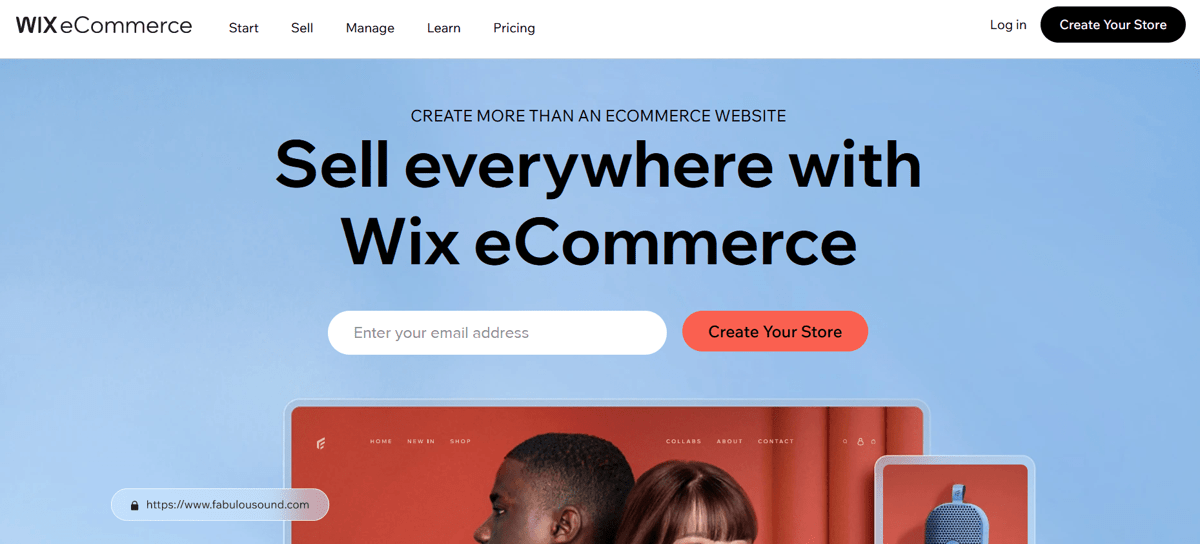
Wix is a website builder with comprehensive eCommerce capabilities founded in 2006 and headquartered in Tel Aviv. The platform supports the sale of digital products, physical goods, and services. Users easily create detailed product pages with multiple images, descriptions, prices, and product variants. Managing stock levels, orders, and returns in real-time is easy via the Wix dashboard. Wix offers built-in abandoned cart recovery features in the form of personalized reminder emails. Users customize the email content, sender details, and timing via the Wix dashboard under Automations.
Wix supports most payment methods and integrates with all popular payment gateways. Payment via cryptocurrency, buy now pay later (BNPL), and recurring payments are also available through third-party providers. Wix does not charge additional transaction fees for using its payment gateways, but standard fees from the payment processors apply. Wix also offers its own in-house payment provider, Wix Payments which accepts all major credit cards, Apple Pay, Google Pay, and more, depending on your location. Service fees on Wix Payments range from 3.1% to 4.3% of the transaction amount plus a small fixed fee.
Downloading the Wix App called Cart Recovery (by MarketPushApps) allows further customization.
Wix provides extensive support via a comprehensive help center, email support, and a community forum. Premium plans offer fast priority support.
How Much Does Wix Cost?
Wix costs between $17 to $159 per month. Wix offers its website builder in four distinct plans: Light, Core, Business, and Business Elite. The Light plan ($17/mo) includes 2 GB storage space, a light marketing suite, and a free domain. The Core plan ($29/mo) offers 50 GB storage space, a basic marketing suite, and basic eCommerce features. The Business plan ($36/mo) provides 100 GB storage space, a standard marketing suite, and advanced eCommerce features. The Business Elite plan ($159/mo) features unlimited storage space, an advanced marketing suite, and an advanced developer platform.
What Are the Pros and Cons of Wix?
There are 5 pros of Wix. The first is a beginner-friendly drag-and-drop editor. The second 900+ professional templates across various industries. The third is multiple affordable plans starting at $17 per month. The fourth is inclusion of SEO tools, social media integrations, and email marketing. The fifth is an extensive app market for additional functionality and customization.
There are 3 cons of Wix. The first is lack of autosave results in lost work if not manually saved. The second is some users report slower site speeds compared to other builders. The third is the inability to change templates without starting over once the site is live.

4. WooCommerce
https://woocommerce.com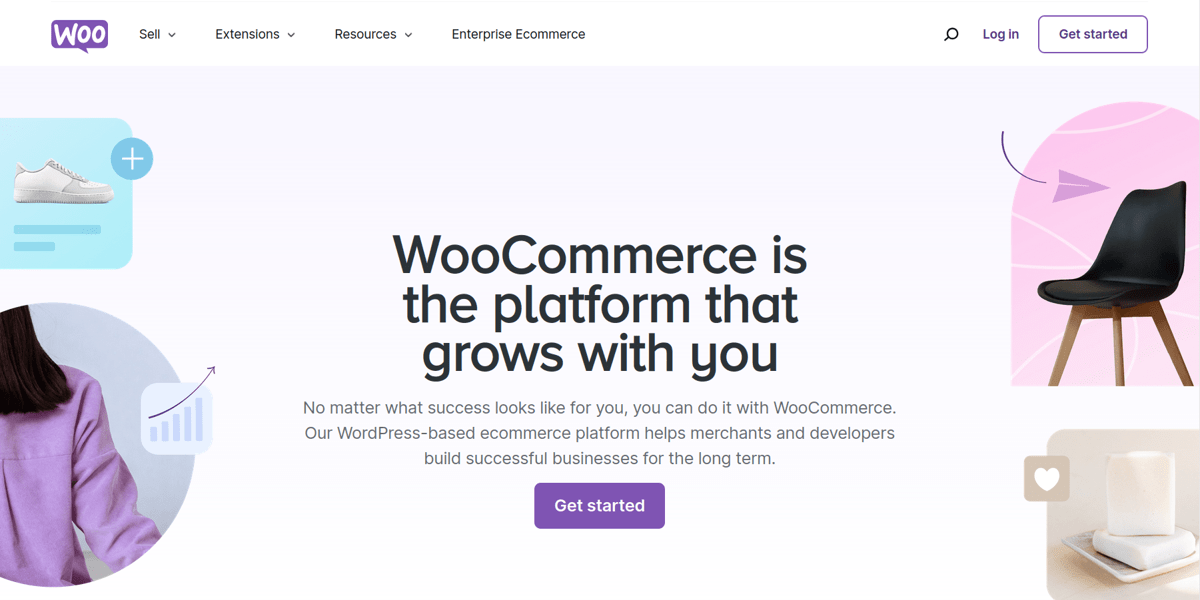
WooCommerce is a leading open-source eCommerce solution offered as a WordPress plugin. It powers over 28.19% of all online stores globally according to BuiltWith Trends. WooCommerce enables you to add comprehensive online store functionality to your existing WordPress website. Once installed and activated, WooCommerce product listings are managed conveniently directly from the WordPress dashboard. WooCommerce does not have built-in abandoned cart recovery, but downloading the WooCommerce Cart Abandonment Recovery extension unlocks it.
WooCommerce also delivers powerful real-time inventory and order management tools. It enables you to track stock levels, oversee orders, and handle returns effectively.
The platform has 79 payment extensions available. It integrates with processors like Stripe and Authorize.net, supports wallets and buy now, pay later services such as Apple Pay and Klarna, and enables in-person payments with Square. WooCommerce also facilitates cryptocurrency payments through gateways like Coinbase. WooCommerce itself does not charge transaction fees, but fees apply depending on the payment gateway.
WooCommerce provides extensive support options from WooCommerce experts, the user community and their knowledgebase. Premium extensions come with live chat support.
How Much Does WooCommerce Cost?
WooCommerce itself is free to download and install, but you’ll need a domain name, hosting service, and a WordPress site to use it. For those using WordPress.com, WooCommerce is included in the Commerce plan priced at $45 per month. Keep in mind that adding extensions and themes incurs additional costs.
What Are the Pros and Cons of WooCommerce?
There are 5 pros of WooCommerce. The first is it is an open-source platform with extensive plugins and themes. The second is it easily integrates with WordPress sites. The third is it supports physical, digital, and subscription products. The fourth is a wide range of payment gateways available. The fifth is community support from a vast user base and developers.
There is 1 con of WooCommerce. Many essential features require paid extensions.

5. BigCommerce
https://www.bigcommerce.com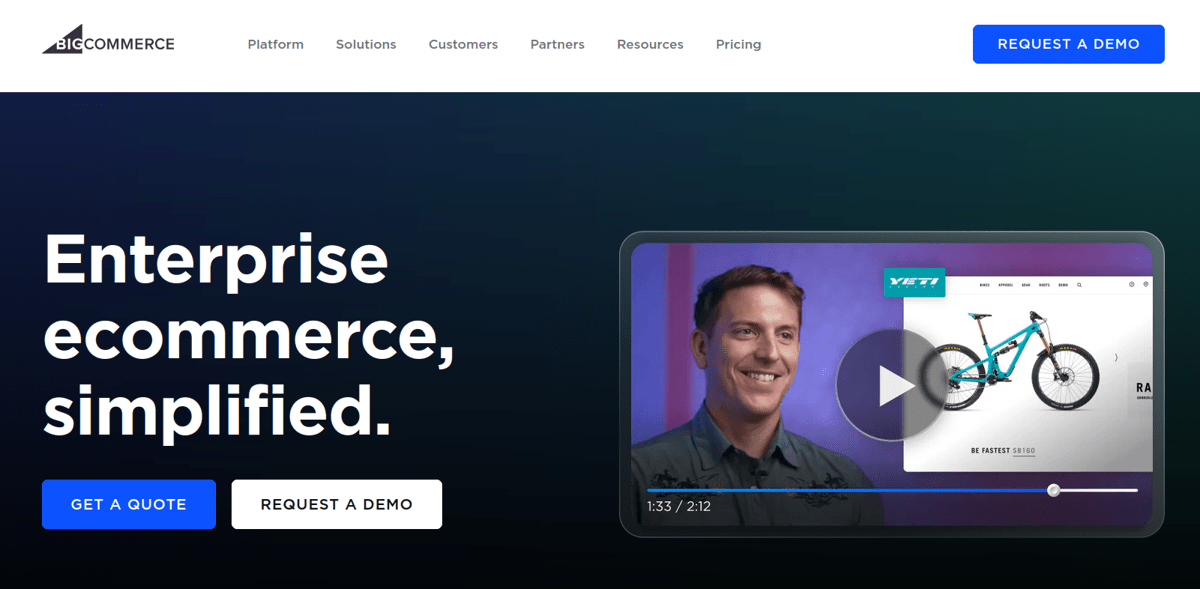
BigCommerce is a robust SaaS eCommerce website builder designed for medium to large businesses, including B2B companies and wholesalers. A standout feature of BigCommerce is its omnichannel selling. This tool allows you to connect your eCommerce store to various marketplaces while managing inventory in one place. The platform also supports listing unlimited products, which allows your business to scale efficiently. BigCommerce’s built-in Abandoned Cart Saver feature automatically sends up to three custom reminder emails to customers who leave items in their carts.
BigCommerce supports over 65 payment gateway integrations. Your store’s country and currency determine the available payment gateways. There’s no limit to the number of payment methods you can set up, but using two or three is recommended. BigCommerce does not charge transaction fees on its plans but has an annual sales threshold. Exceeding the threshold requires an upgrade to a higher plan.
BigCommerce provides extensive support options, including 24/7 customer service through phone, live chat, and email. They also have a comprehensive knowledgebase.
How Much Does BigCommerce Cost?
BigCommerce’s costs start from $29 per month. BigCommerce offers three main pricing plans: Standard at $29 per month, Plus at $79 per month, and Pro at $299 per month. An Enterprise plan is available at a custom price for larger businesses.
What Are the Pros and Cons of BigCommerce?
There are 4 pros of BigCommerce. The first is headless commerce support which means you can use BigCommerce as a backend while having a separate frontend. The second is support for multiple sales channels, including Amazon, eBay, and Facebook. The third is no transaction fees on any plan. The fourth is customer segmentation features provide a more personalized shopping experience.
There are 2 cons of BigCommerce. The first is that going over annual sales limits require you to upgrade your plan once you exceed the threshold. The second is a steeper learning curve due to its advanced features.

6. Sellfy
https://sellfy.com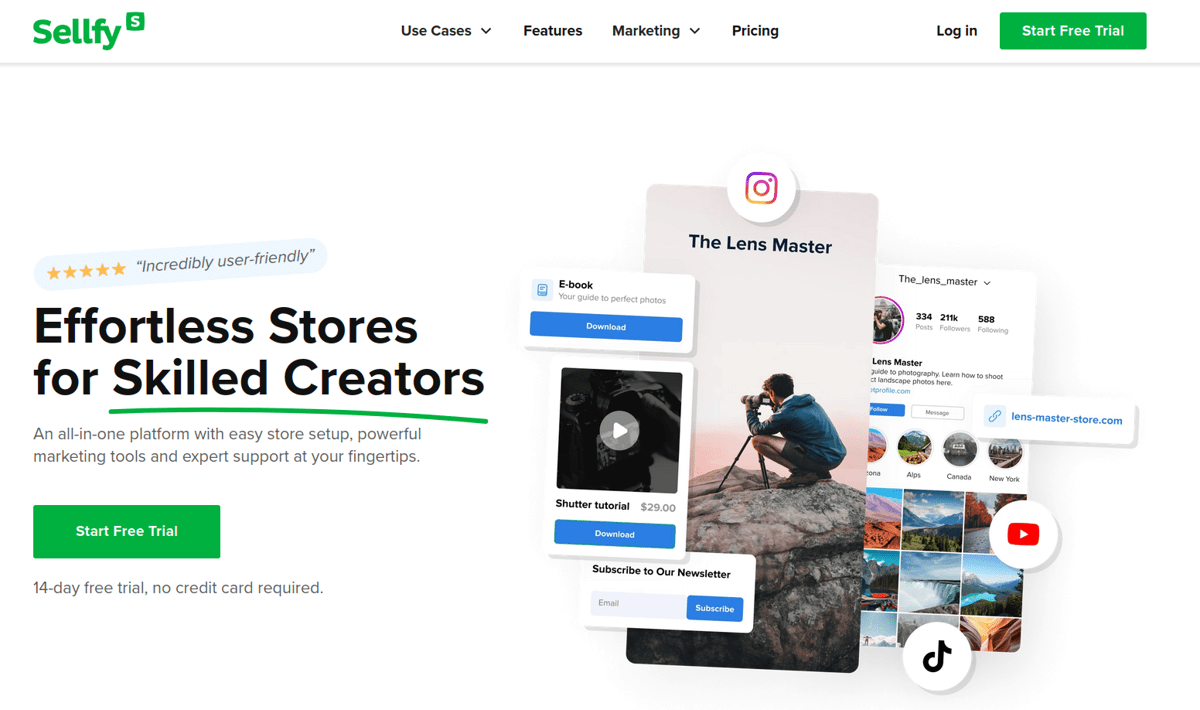
Sellfy is an eCommerce platform that was launched in 2011 and is currently headquartered in Latvia. Sellfy is tailored for selling both physical and digital products. Customers are able to purchase and download files directly from the website, making it popular for creators selling digital goods like eBooks, music, and software.
The platform simplifies order management with features that allow you to embed buy buttons and share product links on social media profiles such as Facebook and YouTube. Cart abandonment recovery features are available in their Business and Premium plans
Sellfy supports payment processing through PayPal and Stripe to ensure secure transactions for your customers. The platform charges transaction fees of 2.9% + $0.30 for US transactions and 3.4% + $0.30 for worldwide transactions.
They also have such as the Pay What You Want option, which allows you to set a minimum fee and let customers decide how much they want to pay. It’s great for collecting donations or testing new product prices.
Sellfy offers 24/7 support via email. Users are also able to reach out through their social media accounts on Facebook, Instagram, and Twitter.
How Much Does Sellfy Cost?
Sellfy costs $19 per month for its Starter plan, $49 per month for its Business plan, and $99 per month for its Premium plan, all billed every two years. Each plan includes a 14-day free trial. The Starter plan allows up to $10,000 in annual sales, the Business plan supports up to $50,000 per year, and the Premium plan accommodates up to $200,000 per year. Users must pay to upgrade to the next subscription level if they exceed the sales limit.
What Are the Pros and Cons of Sellfy?
There are 3 pros of Sellfy. The first is an easy-to-use interface suitable for beginners. The second is built-in marketing tools. The third is support for digital products, physical products, and subscriptions.
There is 1 con of Sellfy. It only supports a few payment gateways.

7. Adobe Commerce (formerly Magento)
https://business.adobe.com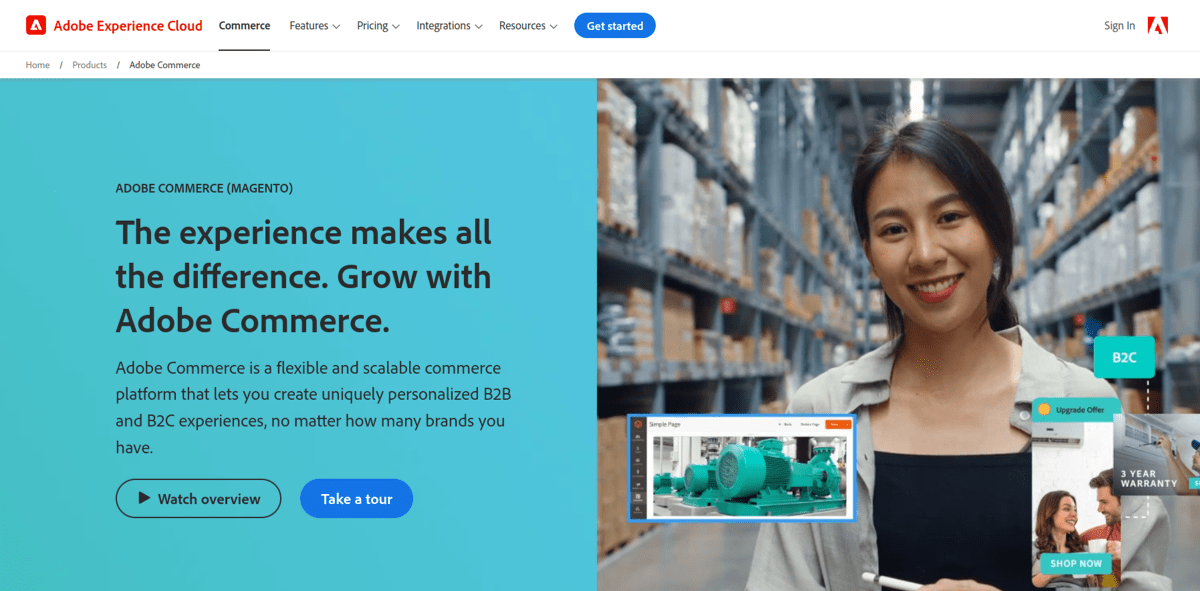
Adobe Commerce (formerly Magento) is a powerful eCommerce platform designed for both B2C and B2B merchants. It’s owned by Adobe. Adobe Commerce combines a robust feature set with the flexibility of an open-source platform, which makes them ideal for enterprises looking to scale. Merchants create detailed product pages with customizable catalogs, pricing, content, and promotions. This flexibility allows for personalized shopping experiences tailored to different customer segments.
Adobe Commerce’s Live Search and Product Recommendations, powered by Adobe Sensei, enhance the shopping experience by providing personalized search results and product suggestions. These features keep customers engaged and reduce the likelihood of cart abandonment. The platform also allows merchants to send automated, customizable follow-up emails to customers if they do abandon their carts.
The platform also offers robust order and inventory management tools, which allows merchants to efficiently track stock levels, manage orders, and process returns. Integrated B2B functionality enhances operations with customer-specific catalogs and pricing.
Adobe Commerce’s Payment Services supports popular payment methods, including debit and credit cards, PayPal, Venmo, and Apple Pay, while ensuring compliance with PCI DSS and 3DS transaction security standards. The system also supports multiple local currencies. The platform itself does not charge transaction fees, but the costs associated with its payment processing varies depending on the chosen payment methods and services.
Adobe Commerce offers support through a ticketing system. This is available to users with Adobe Commerce accounts.
How Much Does Adobe Commerce Cost?
Adobe Commerce’s costs are available only upon request. It offers two main pricing packages: Commerce Pro and Managed Services. These packages include designated cloud infrastructure resources, go-live process coaching, and dedicated escalation management. Specific prices are not provided, but customers are allowed to request a demo before purchasing a subscription to see how it meets their business needs.
What Are the Pros and Cons of Adobe Commerce?
There are 5 pros of Adobe Commerce. The first is a highly customizable platform suitable for large enterprises. The second is robust security features and regular updates. The third is support for multiple storefronts, languages, and currencies. The fourth is extensive third-party integrations and extensions. The fifth is advanced analytics and reporting tools.
There are 2 cons of Adobe Commerce. The first is its high cost. The second is its complexity.

8. PrestaShop
https://prestashop.com
PrestaShop (Classic) is a free, open-source eCommerce solution that requires only a hosting plan for installation. This makes it an accessible option for businesses looking to establish an online presence. Merchants create detailed product listings with customizable options, track stock levels, manage orders, and process returns.
PrestaShop also has a suite of modules to boost sales and conversions, including the Abandoned Cart Reminder module. This automatically sends follow-up emails to customers who leave items in their carts.
PrestaShop includes three payment methods by default: bank transfer, cheque, and PrestaShop Checkout. The PrestaShop Checkout module, created in partnership with PayPal, consolidates various payment methods. Customers pay by credit card, PayPal, or local methods. The platform supports transactions in 20 different currencies across over 190 countries. Merchants are also able to add other payment options like Stripe, Revolut, and Amazon Payments by installing relevant modules from the PrestaShop Marketplace. PrestaShop itself does not charge transaction fees.
PrestaShop offers support through its official documentation and Help Center. Merchants who need additional assistance have the option to get their paid technical support plan for $325.
How Much Does PrestaShop Cost?
PrestaShop’s software is free to install, and only requires the purchase of a hosting plan and a domain. Note that adding extra templates and modules to enhance your store will incur additional costs.
What Are the Pros and Cons of PrestaShop?
There are 5 pros of PrestaShop. The first is it is open-source and free to install. The second is it is highly customizable with numerous themes and modules. The third is it supports multiple languages and currencies. The fourth is strong community support and extensive documentation. The fifth is built-in SEO and marketing tools.
There is 1 con of PrestaShop. It requires technical knowledge for advanced customization and maintenance.

9. Square Online
https://squareup.com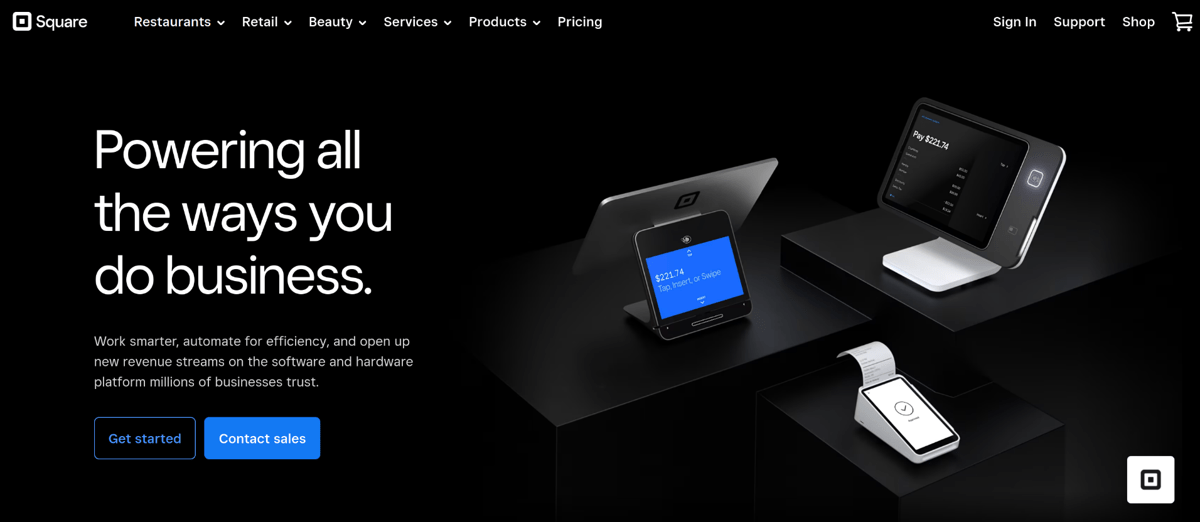
Square Online is a robust eCommerce platform known for its seamless integration with Square’s POS system. This platform is popular among retail and service businesses looking to unify their in-person and online sales operations.Square Online makes it easy to add and manage product listings, and enables you to track stock levels, process orders, and handle returns all from a centralized dashboard. They also have abandoned cart recovery tools like automated email reminders.
Merchants easily connect with various payment processors, including Afterpay, PayPal, and Google Pay. Transactions are processed through Square Online’s secure payment gateway. Square Online charges a transaction fee of 2.9% + 30¢ per online sale.
Square Online provides support in 4 main forms. The first is in-app support via the Square App, Terminal, and Register. The second is direct assistance through the Square Customer Success via live chat, phone, or email. The third is the Square Support Center, which offers guides, articles, troubleshooting tips, and video tutorials. Finally, joining the Square Seller Community lets you learn from other business owners.
How Much Does Square Online Cost?
Square Online costs between $0 to $79 per month. Square Online offers three main pricing plans: Free, Plus, and Premium. The Free plan is ideal for basic use and includes a website builder and SEO tools. It also has a transaction fee of 2.9% + 30¢ per transaction. The Plus plan ($29/mo) offers additional benefits such as custom domains, advanced customization, and customer accounts. The Premium plan ($79/mo) is designed for growing businesses and provides lower transaction fees at 2.6% + 30¢, along with premium support and real-time shipping rates.
What Are the Pros and Cons of Square Online?
There are 3 pros of Square Online. The first is a free plan available with essential features. The second is seamless integration with Square POS. The third is very comprehensive support.
There is 1 con of Square Online. It offers limited tools and features compared to other platforms, such as lack of blogging features.

10. Weebly
https://www.weebly.com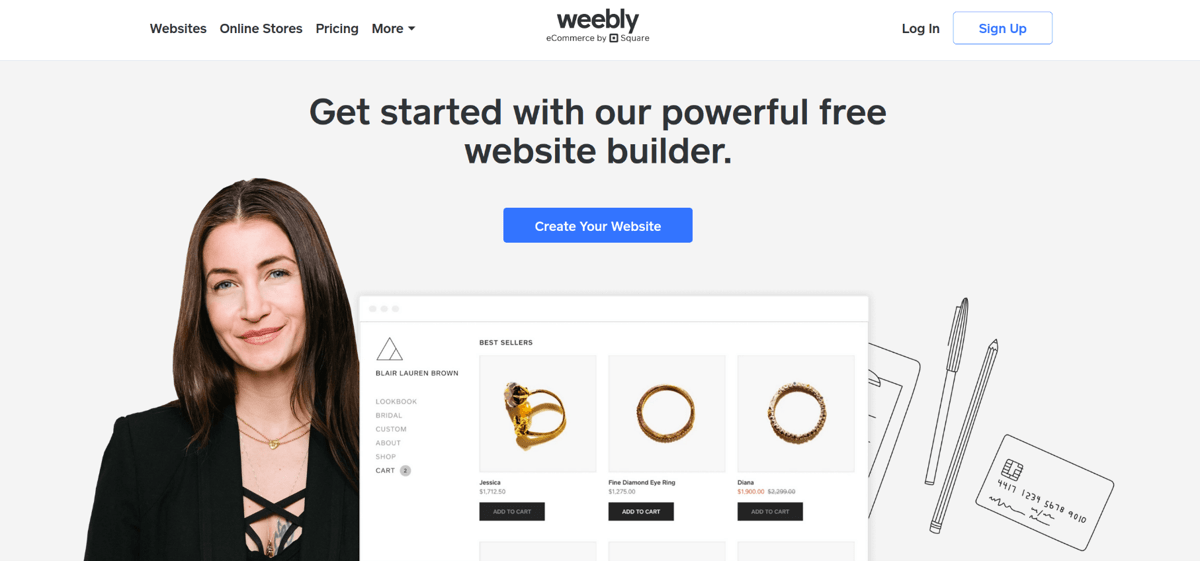
Weebly remains a recognizable name in the website-building industry, and is favored for its user-friendly platform and affordability. Its features are tailored to small businesses and beginners. Weebly enables users to easily list both physical and digital products, manage inventory, and add variations such as size or color.
Weebly’s inventory management tools allow businesses to track stock levels, process orders, and set up shipping options. Features are more limited compared to other platforms. We recommend the Performance plan for those looking for advanced features such as abandoned cart recovery tools like automated emails.
Weebly integrates with major payment processors like Square, Stripe, and PayPal. Users accept payments via credit card, Google Pay, Apple Pay. Payment processing fees vary by provider, with Square charging 2.5%, Stripe ranging from 1.4% to 2.9% + $0.25, and PayPal at 1.9% to 2.9% + $0.38.
Weebly provides 24/7 email support for all users and chat support. Phone support is available for Professional and Performance plan users. The support center includes comprehensive guides and resources, and the Seller Community offers peer support and advice.
How Much Does Weebly Cost?
Weebly costs between $0 to $26 per month. Weebly offers four pricing plans: Free, Personal, Professional, and Performance. The Free plan ($0/mo) includes basic features like free SSL and a shopping cart. The Personal plan ($10/mo) allows you to connect a custom domain, offers unlimited storage, and includes a shipping calculator. The Professional plan ($12/mo) provides advanced site stats, a free domain, and the removal of Square ads. The Performance plan ($26/mo) includes priority support, abandoned cart emails, and advanced eCommerce insights.
What Are the Pros and Cons of Weebly?
There are 3 pros of Weebly. The first is affordable pricing plans, including a free option. The second is an easy-to-use drag-and-drop editor. The third is comprehensive support and a helpful community.
There is 1 con of Weebly. It offers limited customization and more outdated templates compared to competitors.

11. Volusion
https://www.volusion.com
Volusion was founded in 1999, which makes it one of the oldest eCommerce platforms in the industry. They’re known for their drag-and-drop site builder, coupled with a variety of free themes suited for different niches. The platform offers robust product listing capabilities, including the ability to add product ratings and reviews from previous customers.
Volusion offers an advanced inventory tracker that lets users monitor inventory status and set low stock notifications. Detailed analytics tools offer in-depth reports. This includes abandoned cart reports, which allows merchants to identify and recover lost sales.
Volusion supports a variety of payment methods, including credit cards, debit cards, and digital wallets. They charge transaction fees ranging from 0.35% to 1.25% for third-party gateways. The platform ensures secure transactions through Volusion Payments, powered by Stripe. It offers advanced security features and PCI compliance to protect customer data and minimize fraud risks.
The platform provides 24/7 customer support through live chat, email, and phone. Phone support is not available for users on the Personal plan.
How Much Does Volusion Cost?
Volusion costs between $29 to custom pricing per month. Volusion offers four main pricing plans: Personal, Professional, Business, and Prime. The Personal plan ($29/mo) includes 100 products. The Professional plan ($79/mo) supports 5,000 products. The Business plan ($299/mo) allows unlimited products with priority support. The Prime plan has custom pricing and is tailored for high-volume businesses with VIP support. All plans come with free themes and built-in SEO tools. A 14-day free trial is available to get started.
What Are the Pros and Cons of Volusion?
There are 4 pros of Volusion. The first is PCI compliance. The second is comprehensive eCommerce features, including inventory management. The third is a 14-day free trial to test the platform. The fourth is robust support options.
There are 2 cons of Volusion. The first is higher transaction fees. The second is the lack of dedicated blogging tools.

12. Ecwid
https://www.ecwid.com
Ecwid is an eCommerce platform founded in 2009 and is currently headquartered in San Diego, California. It allows merchants to create standalone online stores or integrate with existing websites, social media pages, and online marketplaces. Merchants use it to easily set up and manage product listings. It also automates inventory tracking, shipping, and tax calculations.
Their Abandoned Cart Recovery feature sends automated emails to remind customers about unfinished orders. These emails, sent two hours after cart abandonment, include a list of products left in the cart and a button to complete the order.
Ecwid supports major online payment methods, including credit and debit cards, PayPal, cryptocurrency, and digital wallets like Apple Pay and Google Pay. Ecwid also supports manual offline payment methods such as cash on delivery, bank deposits, and checks. Merchants are also able to set up recurring payments for subscription-based models. Ecwid itself does not charge transaction fees, but total fees vary depending on the payment gateway used.
Ecwid provides 4 support options: a help center, live chat, email, and scheduled phone support.
How Much Does Ecwid Cost?
Ecwid costs between $0 to $89 per month. Ecwid offers four pricing plans: Free, Venture, Business, and Unlimited. The Free plan ($0/mo) provides a basic online store setup. The Venture plan ($21/mo) includes 100 products, selling on Instagram and Facebook, and live chat support. The Business plan ($39/mo) supports up to 2,500 products, subscriptions, and abandoned cart recovery. The Unlimited plan ($89/mo) offers unlimited products, a branded mobile app, and priority support. Ecwid also provides a 14-day free trial to help you get started.
What Are the Pros and Cons of Ecwid?
There are 2 pros of Ecwid. The first is easy integration with existing websites and social media platforms. The second is a user-friendly interface with minimal setup required.
There are 2 cons of Ecwid. The first is the free plan has very limited features, such as up to 5 products only, no discount coupons, and cannot sell digital goods. The second is direct support isn’t available 24/7.

13. Squarespace
https://www.squarespace.com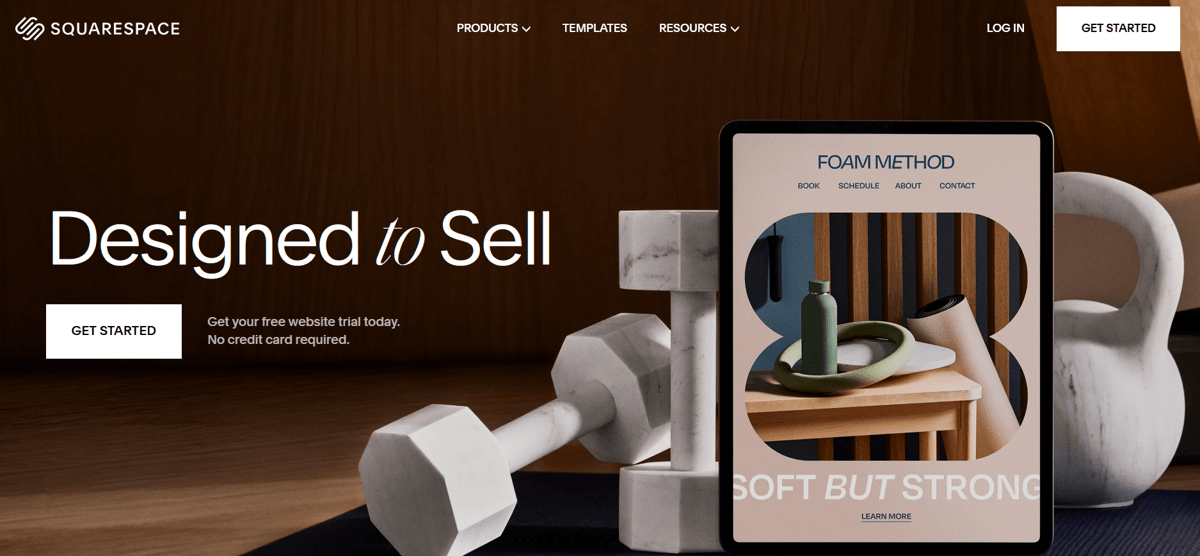
Squarespace was founded in 2003 and is currently headquartered in New York City. Its drag-and-drop editor and templates are popular with beginners and creatives. Users are able to easily set up shipping options, monitor stock levels, and handle returns via their dashboard. Customers on their Commerce Advanced plan get cart abandonment recovery tools, dynamic shipping rates and other custom integrations.
It supports payments via debit and credit card, Apple Pay, and Afterpay through Squarespace Payments (now rolling out in the United States and additional markets). Connecting Stripe also enables acceptance of Visa, Mastercard, and Apple Pay. Squarespace also integrates with Square for in-person sales. The platform charges a 2.9% + 30¢ fee per transaction for payments processed through Squarespace Payments. Consider upgrading to their Commerce Basic or Commerce Advanced plan to avoid transaction fees.
Squarespace offers 24/7 email support and live chat support. Their comprehensive Help Center includes guides, video tutorials, and webinars. Their community forum lets you connect with other Squarespace users.
How Much Does Squarespace Cost?
Squarespace costs between $16 to $49 per month. Squarespace offers four pricing plans: Personal, Business, Commerce Basic, and Commerce Advanced. The Personal plan ($16/mo) includes mobile-optimized websites and free custom domain. The Business plan ($23/mo) adds advanced analytics and professional email from Google. The Commerce Basic plan ($26/mo) removes transaction fees and includes merchandising tools. The Commerce Advanced plan ($49/mo) offers advanced shipping and discounting, plus the ability to sell subscriptions.
What Are the Pros and Cons of Squarespace?
There are 3 pros of Squarespace. The first is a user-friendly drag-and-drop editor. The second is over 160 templates to choose from. The third is excellent customer support with various channels.
There are 2 cons of Squarespace. The first is limited creative control due to grid-based design constraints. The second is the lack of an autosave feature during editing.
What Is an eCommerce Platform?
An eCommerce platform is a software solution that allows businesses to create, launch and manage a range of eCommerce website types. They provide tools for listing products, processing payments, managing orders, tracking inventory, and improving conversions. Most eCommerce platforms also include features for marketing, customer management, and analytics to help businesses sell products and services online efficiently. Many eCommerce platforms also offer hosting services and integrate with online marketplaces, thus providing a comprehensive solution for anyone looking to start an eCommerce business.
eCommerce Platform vs eCommerce Hosting: What Is the Difference?
The difference between eCommerce Platform vs eCommerce Hosting is that an eCommerce platform specializes in software for creating and managing online stores, while eCommerce hosting is simply the service provided by web hosts that are optimized to support eCommerce businesses. An eCommerce platform offers features for product listings, payments, and inventory management. eCommerce hosting is chosen from a web host provider when businesses want more optimized server space and technology and performance. Learn more about the best eCommerce hosting services if you’re taking this path.
eCommerce Platform vs Marketplace: What Is the Difference?
The difference between an eCommerce platform and a marketplace is that an eCommerce platform refers to the software used to build eCommerce websites, and a marketplace is a niche type of eCommerce website that utilizes a distinct multi-vendor selling model. Three example marketplaces are Amazon, eBay or Etsy.
What Are the Types of eCommerce Platform?
There are two types of eCommerce platforms: hosted and self-hosted.
Hosted platforms provide an all-in-one solution, including hosting, software, and support. Examples include Shopify, Wix, BigCommerce, and Volusion. Hosted platforms require minimal technical knowledge, which make them ideal for businesses looking for a straightforward setup.
Self-hosted platforms offer superior customization and control by allowing businesses to host the store using specialized web hosting providers. Example self-hosted eCommerce platforms include WooCommerce, Adobe Commerce, and OpenCart because they need to be paired with a third-party web host of your choice. Self-hosted platforms require more technical expertise but provide greater flexibility and scalability for businesses with specific needs.
What Are the Advantages of Hosted eCommerce Platform?
There are three advantages of hosted eCommerce platforms. The first is automatic updates. These ensure that the platform is always up-to-date with the latest feature versions and security patches without any effort from the user. The second is dedicated support. This gives users access to professional help whenever needed, which is crucial for resolving issues quickly. The third is hassle-free setup and maintenance. Hosted platforms handle the technical aspects of hosting and servers, which allow businesses to focus on selling products and growing their brand.
What Are the Advantages of Self-Hosted eCommerce Platform?
There are three advantages of self-hosted eCommerce platforms. The first advantage is advanced control over the hosting component of your site. This is because users now have the power to choose a reputable web host brand that specializes in eCommerce hosting, which is hosting that is optimized to support the unique needs of eCommerce businesses. Users also have more control over the type of web hosting supporting their site.
The second advantage is high customization. Self-hosted platforms offer extensive options for modifying server settings and optimizing performance. For example, many eCommerce owners choose Virtual Private Server (VPS) hosting which is a type of hosting that provides root access and therefore unlocks maximum control over server settings.
The third advantage is ease of migration. Self-hosted businesses are able to move their store to a different hosting provider with fewer disruptions or limitations, unlike some hosted platforms that lock you into their ecosystem.
Should I Start an eCommerce Website With a Hosted or Self-Hosted eCommerce Platform?
Starting an eCommerce website with a self-hosted platform like WooCommerce combined with a reliable web host that offers eCommerce hosting is often the best choice. Self-hosted platforms provide greater control and flexibility, which enables businesses to optimize performance according to their unique requirements. See more tips on creating an eCommerce website.
How Do I Choose an eCommerce Platform?
You must choose an eCommerce platform based on examining how it handles 3 criteria.
The first are product listings. Evaluate how the platform handles product listings, including the ease of adding, editing, and organizing products. Look for features like bulk uploads, inventory management, and options for digital and physical products.
The second are transaction fees. Check the transaction fees charged by the platform. Some platforms have no transaction fees, while others charge a percentage of each sale. Understanding these fees help you choose a platform that maximizes your profit.
The third is support. Look for platforms that offer 24/7 support via multiple channels such as live chat, email, and phone. Reliable customer support is crucial for resolving issues quickly.
What Is the Best eCommerce Platform for Dropshipping?
The best eCommerce platform for dropshipping is WooCommerce. WooCommerce provides 3 features essential for dropshipping success. The first is seamless scalability as your dropshipping business grows, since you simply upgrade your web hosting package. The second is access to a wide range of WooCommerce dropshipping plugins such as AliDropship Woo, DropshipMe, and Zendrop. The third is the ability to install additional WordPress plugins to enhance your dropshipping site’s speed and search engine optimization.
What Is the Best eCommerce Platform for Small Business?
The best eCommerce platform for small businesses is Hostinger Website Builder. Hostinger Website Builder provides three key features essential for small business success. The first is a user-friendly interface with a very simple setup. The second is affordable pricing plans. The third is reliable customer support.
Which Is the Best eCommerce Platform?
The best eCommerce platform offers an intuitive interface, robust features, and seamless scalability.
Hostinger Website Builder is our #1 pick based on the criteria above.
